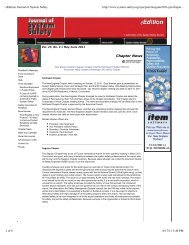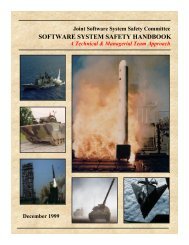Air Force System Safety Handbook - System Safety Society
Air Force System Safety Handbook - System Safety Society
Air Force System Safety Handbook - System Safety Society
Create successful ePaper yourself
Turn your PDF publications into a flip-book with our unique Google optimized e-Paper software.
evaluated so that an acceptable method for risk reduction can<br />
be pursued.<br />
The order of precedence for satisfying system safety requirements<br />
and resolving identified hazards is:<br />
a. Design for Minimum Risk. From the first, design to<br />
eliminate hazards. If an identified hazard cannot be<br />
eliminated, reduce the associated risk to an<br />
acceptable level, as defined by the MA, through<br />
design selection. Defining minimum risk is not a<br />
simple matter. It is not a cookbook process that can<br />
be numerically developed without considerable<br />
thought. Minimum risk will vary from program to<br />
program. See paragraph 3.6 for more information.<br />
b. Incorporate <strong>Safety</strong> Devices. If identified hazards<br />
cannot be eliminated or their associated risk<br />
adequately reduced through design selection, that<br />
risk shall be reduced to a level acceptable to the MA<br />
through the use of fixed, automatic, or other<br />
protective safety design features or devices.<br />
Provisions shall be made for periodic functional<br />
checks of safety devices when applicable.<br />
c. Provide Warning Devices. When neither design nor<br />
safety devices can effectively eliminate identified<br />
Yes<br />
Provided Risk<br />
Assessment Package<br />
for Management<br />
Conclude Hazard<br />
Analysis<br />
Design to<br />
Eliminate<br />
Hazard<br />
Provided?<br />
No<br />
Yes<br />
Design to<br />
Reduce<br />
Hazard<br />
Provided?<br />
Yes<br />
Figure 3-2<br />
HAZARD REDUCTION PRECEDENCE<br />
No<br />
Yes<br />
Provide<br />
<strong>Safety</strong><br />
Devices<br />
Provided?<br />
Yes<br />
21<br />
hazards or adequately reduce associated risk,<br />
device<br />
shall be used to detect the condition and to produce<br />
an adequate warning signal to alert personnel of the<br />
hazard. Warning signals and their application shall<br />
be designed to minimize the probability of incorrect<br />
personnel reaction to the signals and shall be<br />
standardized within like types of systems.<br />
d. Develop Procedures and Training. Where it is<br />
impractical to eliminate hazards through design<br />
selection or adequately reduce the associated risk<br />
with safety and warning devices, procedures and<br />
training shall be used. However, without a specific<br />
waiver, no warning, caution, or other form of written<br />
advisory shall be used as the only risk reduction<br />
method for Category I or II hazards. Procedures<br />
may include the use of personal protective equipment.<br />
The process for reducing risk due to a hazard is illustrated in<br />
Figure 3-2. (40:40) It is an obvious interaction of both<br />
engineering and management considerations to bring about<br />
an optimal resolution of risk. Final resolution rests in the<br />
decision made by the managing activity.<br />
No<br />
Provide<br />
Warning<br />
Devices<br />
Provided?<br />
No<br />
Provide<br />
Special<br />
Procedures<br />
Provided?<br />
No<br />
Terminate<br />
<strong>System</strong><br />
Out




